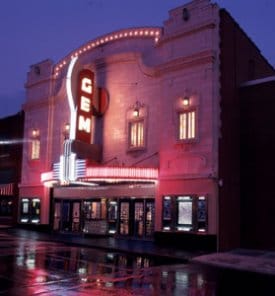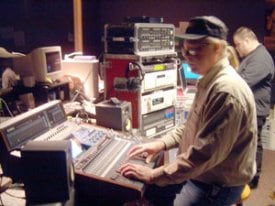Yamaha 02R96 Captures Jazz Vocalist Kevin Mahogany
|
March 28, 2003 — Vocalist Kevin Mahogany combines the best of traditional jazz and modern R&B styles. With successful albums on the Enja and Warner Brothers labels, the singer maintains a busy schedule of recording and touring while teaching at Boston's Berklee College of Music. Mahogany honed his craft on the Kansas City scene, and stays true to those roots with frequent appearances at local venues.
Recently, Mahogany appeared in "Jammin' at the Gem," part of the regular season at Kansas City's historic Gem Theater Cultural & Performing Arts Center, with a backing combo that included Phil Upchurch on guitar, Red Holloway on sax, Grady Tate on drums and Norman Simmons on piano. To capture the event for a possible live album project, Mahogany enlisted the help of longtime friend and engineer Doug Walker, vice president of dBVisionWorks of Overland Park, KS, a company which has a division specializing in custom recording and postproduction. "Kevin called and asked me to record the show, since he had some pretty strong players with him," explains Walker. "Since this was to be an intimate setting, we agreed that we should really capture that atmosphere, so I chose a new Yamaha 02R96 for the job. I've been an 02R user for a number of years, and always had consistent, clean recordings. That's particularly important when recording jazz – that is, no coloration, and allowing the performances to really speak for themselves. Sonically, the Gem is pretty live, but not overbearing." Originally called the Star, the Gem Theater opened in 1912 and closed in the 1960's. Its 18th and Vine street address had been the center for the city's African-American business community and the spot where blacks and whites gathered to hear jazz – one of KC's best known contributions to America's heritage (second perhaps only to big steaks). In 1995, a massive renovation project saw the theater reopen as The Gem Theater Cultural & Performing Arts Center. The 20,000 square-foot, 500-seat venue now shares the famous intersection with the Kansas City Jazz Museum, Visitors' Center and Negro Leagues Baseball Museum. "There's a lot of detail in the room, so I could get the mix right fairly up front," Walker notes. "We didn't have time to do a big sound check, but I had been able to set up things prior to the gig, particularly the input and output patching, which was a plus. I didn't have a manual, but I was an expert in a few days. The assignable function buttons, the ability to quickly get to areas are real innovations."
"Another good thing was that I got to record in what resembled an iso booth," he continues, "almost like having my own control room. The room had been the original house mix position, but since it was all behind glass, that board had been moved out into the house. I dropped my own snake and plugged into a 24-channel splitter which came from the house, and listened through a pair of KRK V6 reference monitors." Walker's gear for the tracking included an Apple MAC G4 laptop running LOGIC Audio Platinum, a pair of MOTU 896 Interfaces and FireWire drive, several hard disk recorders, CD Burner and DAT. "Having read the reviews on the 02R96, I knew it was possible to run several redundant recordings," he says. "Since the console allowed me to assign outputs and each one of the slots to the direct outs, buss outs and the aux outs, each machine could receive independent sends. If one went down, we weren't dependent on signal running through it to another machine. I was also able to set up different levels, and since each input and output patch has a library of its own, I could visualize being able to recall any of those patches and assign them to any of the scene memories without having to reset. "I've always liked the absence of floor noise in the 02R products," he adds, "but the 96k version has things I never thought of – like being able to patch in the insert, being able to utilize the insert to patch in a preamp or an outboard effect, and not only have that apply to that specific channel, but be able to use that input and output patching to route it to another channel or directly to an output. The mic pres are top quality; we had a $4,000 outboard 2-channel preamp for comparison, and found that the 02R96 had as much transparency and less coloration. "We decided to record in 24-48, since this concert may be part of a live CD, and we weren't sure what facility would receive it after the recording. I also did a 2-track mix off of the board so it could be previewed, and used the onboard effects of the 02R96. Having an analog feel to the EQ section made things much faster, plus having potentiometers for the gate and compressor, and being able to run them simultaneously on the same channel is great. Having 24-bit depth has really increased the dynamic range, and that's valuable in a jazz setting where the music goes from pianissimo to double forte. "Our mics included Sennheiser KM84s, Audio Technica 4040s and 4050s EV RE20s and Crowns for a total of around 16 channels. The musicians sat close to each other, even though the stage is huge. They didn't spread out because they're accustomed to a semi-circle eye contact-type setting. However, there was very little bleed. Everything had a lot of clarity." Walker took the rough tracks and the 02R96 back to his facility, where he is currently doing mixes. "I'm getting a feel for the automation," he notes, "and the dithering on the digital I/O side. My Fostex is a 16-bit machine, and the other pieces are 24-bit, but I was able to use a single slot and assign it to a 16-bit dithering, leaving everything else at 24, so there were no word clock problems. I'm working from the LOGIC audio files (which are 24-bit/48K) using the Sound Designer II format, and those files are easily exported to Pro Tools. So far, the result is a lot of good tracks. Kevin and I are pleased." For more information on the 02R96, write Yamaha Corporation of America, Professional Audio, P.O. Box 6600, Buena Park, CA 90622; telephone (714) 522-9011 or e-mail infostation@yamaha.com.
|



